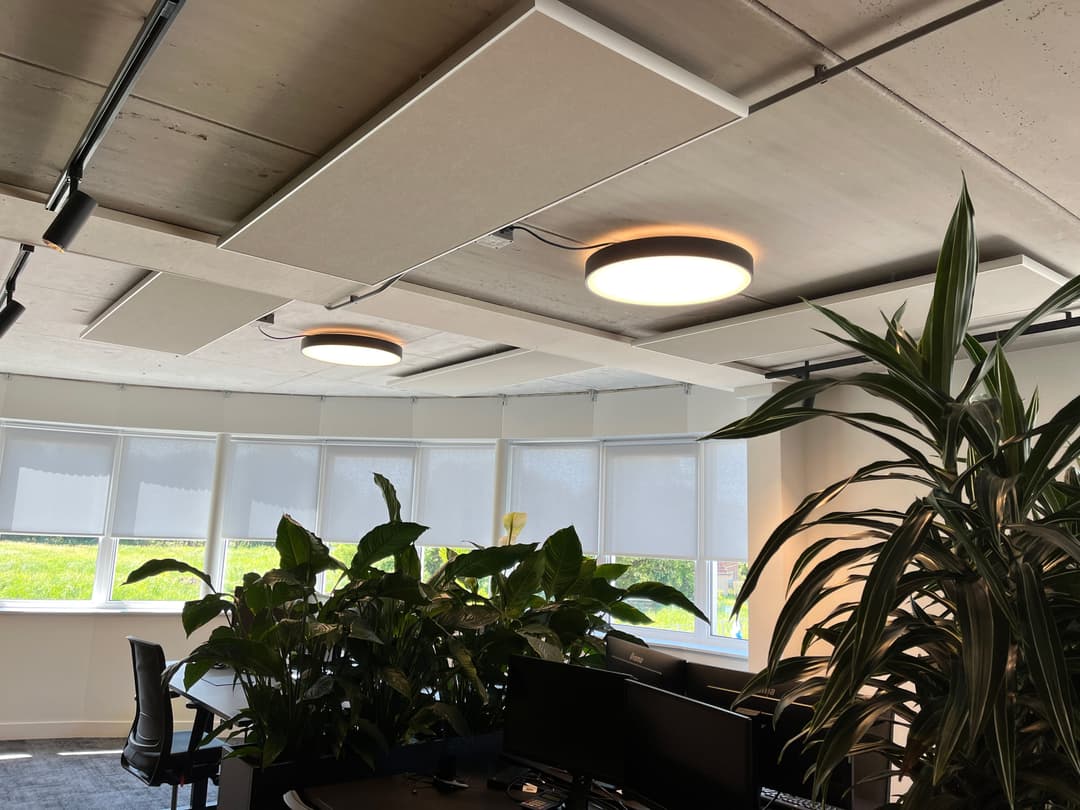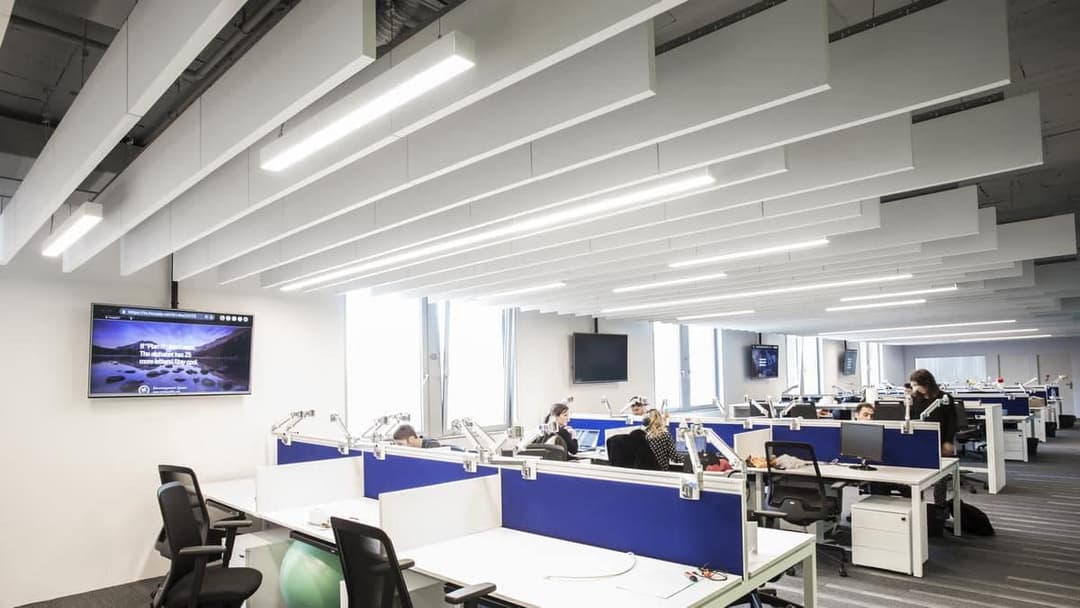Improving office acoustics for a productive working environment
Are you struggling with poor office acoustics? Good acoustics are essential for a productive and comfortable working environment. Sound problems in the office can lead to decreased concentration, increased stress, and lower productivity. In this article, you will discover how to optimise the acoustics in your office environment, what factors play a role in this, and which solutions are the most effective.
Why is good acoustics in the office so important?
Poor acoustics in the workplace have far-reaching consequences. Research shows that noise has a direct impact on our mood, productivity, and overall well-being. In a quiet environment, our memory works better and we can concentrate for longer. When there is too much distraction from noise, complex tasks become more difficult to perform and productivity drops significantly.
When improving the office acoustics, you need to take various factors into account:
- Nagalm in space
- Sound transmission between workplaces
- Sound reflections via walls and ceilings
- Ambient noise from equipment and installations
An investment in better acoustics pays off significantly. Not only does it improve the work atmosphere, but it also contributes to the well-being of employees and increases efficiency. Did you know that employees take about 25 minutes to regain their focus after a distraction? This highlights how important a good sound environment is.
How does poor acoustics arise in the office?
The causes of echo
Reverberation occurs when sound waves reflect between hard surfaces such as:
- Concrete floors and ceilings
- Glass walls and windows
- Metal constructions
- Hard furniture
In modern offices, many of these materials are often used, resulting in an acoustically unfavourable environment. Sound reflects off these surfaces and creates an echo that reduces clarity and causes distractions.
Sound transmission between workplaces
In open-plan offices, sound transmission between workstations is a common issue. Conversations, phone calls, and other noises easily carry through the space, leading to:
- Reduced privacy
- Distractions during concentration tasks
- Increased stress levels
- Lower productivity
Without adequate acoustic barriers, sound can travel freely through the space, which is particularly problematic in open-plan offices and shared workspaces.
Benefits of improving office acoustics
1. Increased productivity and health
A good acoustic environment reduces fatigue, stress, and ultimately absenteeism. Employees can concentrate better and work more efficiently when they are less distracted by environmental noise. This leads to:
- Better performance on complex tasks
- Fewer errors in work
- Lower sickness absence
- Higher employee satisfaction
2. Improved speech privacy
By strategically placing acoustic partition walls and desk screens, direct sound transmission between workspaces is reduced. This results in:
- More privacy during conversations
- Less interference with each other
- Better concentration opportunities
- More comfortable work environment for everyone
3. Reduced overall noise level
With acoustic solutions such as ceiling panels and wall panels, the overall noise level in the space is reduced. As a result:
- Sound travels less far
- Reduces sound pressure
- Improves overall sound quality
- Creates a more pleasant working environment
4. Better understandability
By reducing reverberation with absorptive materials, speech intelligibility improves significantly. This is especially important in:
- Meeting rooms
- Call rooms
- Presentation rooms
- Collaboration areas
Effective solutions to improve office acoustics
Acoustic ceiling solutions
Ceiling solutions are particularly effective because they directly address the vertical sound reflections:
- Ceiling Islands: These free-hanging panels absorb sound from all directions and are ideal for spaces where a fully suspended ceiling is not possible or desirable.
- Direct Ceiling Panels: These are mounted directly onto the ceiling and provide excellent sound absorption.
- Acoustic Baffles: These vertically hanging elements are perfect for high spaces and provide absorption from multiple directions.
Wall solutions for better acoustics
Wall panels help reduce horizontal sound reflections:
- Acoustic wall panels: These can be customised to fit the interior and are available in various colours, fabrics, and designs.
- Photo panels: Combine functionality with aesthetics by integrating personal images or corporate branding into acoustic solutions.
Partition walls for offices and desk screens
For direct sound barriers between workplaces:
- Desk screens: These create a direct barrier between workspaces and reduce sound transmission.
- Floor screens and dividers: Ideal for creating semi-private work areas in open office spaces.
- Acoustic booths: For tasks that require full concentration or privacy.
Design and sustainability in acoustic solutions
When improving the office acoustics, you do not have to make compromises on design. Modern acoustic solutions are available in:
- Various colours and materials
- Customisable prints and designs
- Sustainable and recyclable materials
- Integrable lighting and functionality
An office is more than just a workplace - it is a part of your business identity. Acoustic solutions can be tailored to your interior and branding, ensuring they fit seamlessly into your office environment.
Sustainability is also an important aspect. There are various environmentally friendly options available, such as:
- 100% recyclable PET felt panels
- Materials with a low environmental impact
- Circular solutions that can be reused at the end of their life cycle
Practical steps to improve office acoustics
1. Start with an acoustic measurement
Before you invest in solutions, it is wise to map out the current acoustic situation. A professional measurement provides insight into:
- The reverberation time in different spaces
- Problematic frequencies
- Sound transmission between work areas
- Specific problem areas that need attention
2. Choose the correct combination of solutions.
Based on the measurements and the specific needs of your office, you can select a combination of solutions:
- For large open spaces: ceiling islands and baffles
- For workstations: desk screens and dividers
- For meeting rooms: wall panels and ceiling absorption
- For reception areas: decorative acoustic elements
3. Implement in phases
You can improve the office acoustics in phases, starting with the most problematic areas:
- Start with the areas where employees are most affected by noise
- Implement basic solutions such as ceiling and wall panels
- Add targeted solutions such as desk screens where necessary
- Evaluate the results and adjust as needed
Common acoustic problems and solutions
Problem: Too much echo in meeting rooms
Solution: Combination of ceiling islands and wall panels to reduce reflections and improve speech intelligibility.
Problem: Sound transmission in open office spaces
Solution: Strategically placed partition walls in offices, desk screens, and acoustic dividers to block direct sound transmission.
Problem: Noise from equipment and installations
Solution: Targeted absorption around noise sources and possibly shielding or isolating equipment.
Problem: Poor speech privacy between workplaces
Solution: Combination of sound-absorbing materials and sound masking systems to keep confidential conversations private.
Conclusion: An investment in acoustics is an investment in productivity.
Improving the office acoustics is one of the most effective ways to optimise the work environment. Good acoustics contribute to:
- Higher productivity and concentration
- Better employee wellbeing
- Less stress and fatigue
- A more professional appearance for your office
By investing in the right acoustic solutions, you create a working environment where employees can perform at their best and feel comfortable. This makes it not only a technical investment but also an investment in your most valuable asset: your people.
Seek professional advice for your specific situation.
Every office environment is unique and requires a tailored approach for optimal acoustics. Consult with acoustic specialists who:
- Be able to conduct a thorough analysis of your current situation
- Be able to propose practical and goal-oriented solutions
- Take your budget and aesthetic wishes into account
- Be able to provide professional installation
Invest today in better office acoustics and experience the difference in productivity, wellbeing, and job satisfaction!
Contact us


